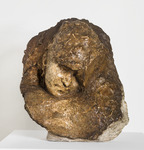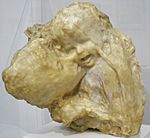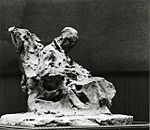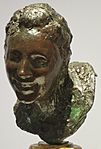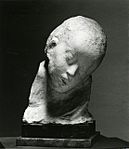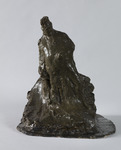Medardo Rosso facts for kids
Medardo Rosso (born June 21, 1858 – died March 31, 1928) was a famous Italian sculptor. He is known for his unique style, which is often called Post-Impressionist. Another famous sculptor, Auguste Rodin, admired Rosso's work.
Contents
Rosso's Life and Art
Early Life and Training
Medardo Rosso was born in Turin, Italy, in 1858. His father worked for the railway. When Medardo was twelve, his family moved to Milan.
At age 24, after serving in the army, Rosso joined the Brera Academy art school. However, he was soon asked to leave. He had tried to get students to sign a paper asking for real people and body parts to be used in drawing classes. This was a common practice in art schools at the time, but Rosso was very passionate about it.
An old book from 1889 described Rosso's early art days. It said he didn't like strict school rules or methods. He wanted to find his own way. Even though he was often alone without teachers or friends, he felt his artistic strength grow. He started to see art in a new way and began to create his own works.
Early Sculptures in Milan
Starting in 1881 in Milan, Rosso began making sculptures. These were mostly bronze busts (head and shoulders) and figures. His early works, like The Hooligan (1882) and Kiss Under the Lamppost (1882), showed a Realist style. This meant they looked very true to life.
After 1882, Rosso's style began to change. He might have discovered Impressionism, an art movement focused on capturing fleeting moments and light. Some of his new works, like Portinaia (Concierge) (1883–84) and Carne altrui (Flesh of Others) (1883–84), started to look less detailed. They had softer shapes and surfaces, which made light and shadow play differently on them.
Rosso never drew his sculptures first. He worked directly with clay. From the clay, he made a plaster model. This plaster model was then used to create a mold. He would then pour bronze into this mold using a method called cire perdue (lost-wax casting). He also made sculptures from plaster and, later, wax with a plaster inside.
Some art experts think Rosso went to Paris in 1884. They believe he worked in the studio of sculptor Jules Dalou. However, there is no clear record to prove this. Rosso continued to make small sculptures in Milan through the mid-1880s. He also created designs for public monuments, like a funeral monument for a writer named Filippo Filippi.
Moving to Paris and New Ideas
In 1889, Rosso moved to Paris, France. He lived and worked there until after World War I. In Paris, he met many important people. One was the writer Emile Zola. Rosso convinced Zola to say he owned one of Rosso's sculptures, which helped make Rosso more famous. He also met Henri Rouart, an engineer and art supporter, and made a bronze portrait of him.
While in Paris, Rosso started to use photography in his studio. He would take pictures of his sculptures in different lighting. He also changed the photos by cropping, folding, or painting them. This helped him show his sculptures in new ways and capture different feelings.
Light and Sculpture
Rosso cared a lot about how light affected his sculptures. He wanted the solid shape of his art to seem to change with the light. He used rough, quick modeling for his sculptures. He would then cast them in bronze, plaster, or wax.
Rosso had his own workshop in Paris where he did his own casting. Most sculptors sent their molds to special factories. But Rosso liked having control. This allowed him to change the surfaces of his works in unusual ways. He sometimes even kept "mistakes" from the casting process. He also didn't always clean off all the plaster left on a bronze work after casting.
For Rosso, these choices helped create special visual effects. He believed that the material of the sculpture was less important than how the viewer saw it. He once said that a sculpture should be seen, not touched. He felt that light was essential to art. He believed that our eyes, not our hands, help us truly understand a work of art.
Later Years and Legacy
Rosso kept his studio in Paris. He showed his sculptures and sold them to important collectors and museums. He became friends with Auguste Rodin, another famous sculptor. They even traded artworks. However, their friendship ended after a public discussion about who influenced whom. Rosso felt Rodin didn't give him enough credit.
In 1906, Rosso created his last new sculpture, Ecce puer (Behold the Child). He had tried many times to make a portrait of a five-year-old boy named Alfred William Mond. One day, Rosso saw the boy standing behind a curtain. This moment inspired the final look of the sculpture.
For the last twenty years of his life, Rosso didn't create any new subjects. Instead, he focused on making new versions of his older works. He died in Milan in 1928, at the age of 70.
Exhibitions of Rosso's Art
Many museums have shown Medardo Rosso's work.
- From October 2 to November 23, 1963, The Museum of Modern Art in New York held an exhibition called Medardo Rosso, 1858-1928. This was the first big museum show of his art in the United States.
- From October 17, 2014, to June 27, 2015, the Center for Italian Modern Art showed Rosso's sculptures, drawings, and experimental photographs. This exhibition highlighted his wide range as an artist.
- From November 11, 2016, to May 13, 2017, the Pulitzer Arts Foundation in St. Louis presented Medardo Rosso: Experiments in Light and Form. This was the largest exhibition of his work in a U.S. museum since the 1963 show.
Key Sculptures by Rosso
- Portinaia (Concierge), 1883
- Carne altrui (Flesh of Others), 1883–84
- Impressione d'omnibus (Impression of an Omnibus), 1884–87 (This work was later destroyed)
- Aetas aurea (Golden Age), late 1885–86
- Enfant au sein (Child at the Breast), late 1889-90
- Bambino ebreo (Jewish Boy), 1892
- Bookmaker, 1893–95
- Enfant malade (Sick Child), 1893–95
- Yvette Guilbert, 1895
- Madame X, 1896
- Ecce puer, 1906
Selected Sculptures
See also
 In Spanish: Medardo Rosso para niños
In Spanish: Medardo Rosso para niños



